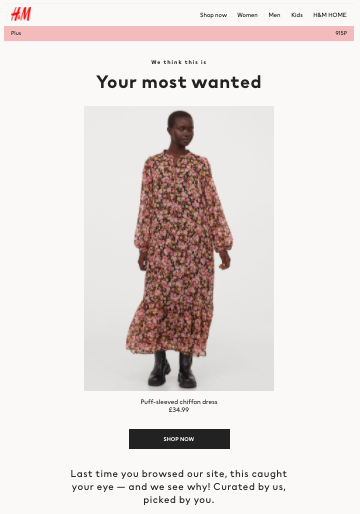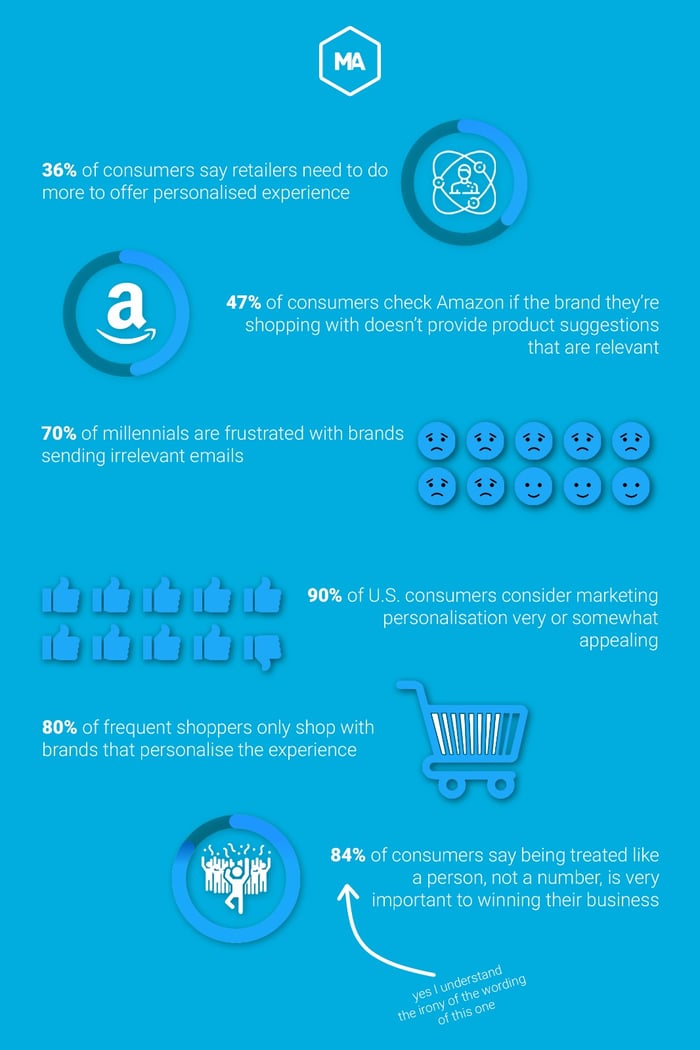Hey Stephen Jones. We just knew you'd love an article on content personalisation, because of all those 'Steve' keyrings you keep buying from giftshops. We also ran the data on your Netflix account. Might be good to lay off the novelty dating shows while going through a break up, yeah?

Okay, if you're a Stephen Jones with a penchant for Love is Blind, that's really going to freak you out. But you'll also be pleased as punch. Why? Because people love personalisation.
In fact, according to a study from the University of Texas, preference for personalised experiences is down to two key factors: desire for control and reducing information overload, i.e. slimming down the information to just what you need to focus on, which is yourself. With our constant exposure to a wealth of data, it's not surprising that these two factors are sought.
Plus, hearing your own name, in comparison to other names, triggers greater brain activation, particularly in the middle frontal cortex. So there's something going on.
I mean, the Association of National Advertisers didn't declare "personalisation" as Word of the Year 2020 for nothing. But then, Gartner predicted that 80% of marketers would abandon their personalisation efforts by 2025. So, who's right?
Well, what we do know is that static content is a thing of the past. New personalisation tech makes websites dynamic, and constantly moving, based on the visitor. Content will change to provide an experience tailored to the user. And it's not for nothing.
Personalisation means that users remain on your site for a longer period of time, and engage in more offers. Plus, personalised websites can increase conversions by up to 70%.
But the thing is personalisation isn't a competitive advantage. It's expected. 31% of customers want more personalisation in their shopping experience than they currently have, with only 22% being satisfied with the level they already receive.
Many brands are already putting each specific customer at the forefront of their marketing, with the customer experience being placed above most other things. Think Amazons, Netflix, Twitter etc. This means pushing personalised offers and experiences.
Often, brands can be inward focusing, promoting themselves as the only focal point. Which makes sense, considering you're selling you or your product. But your customers don't want to know why you're good, they want to know why you're good for them. By personalising their experience, the customer is in control, and this will build a strong relationship based in connection and trust. How sweet.
Why personalisation works
Basically, it's because it's about the customer. Personalisation reflects the customer's actual interests, not just the actions you hope they'll take.
As a result, it'll improve "engagement, brand preference, loyalty, and sales by delivering highly personalized experiences that customize your site to each visitor," according to Search Engine Watch.
Plus, it works alongside data collection.
"As many companies collected, stored and sold mass quantities of online data, the rapid decline of customer trust began crumbling down.
"And although marketers had a sea of customer data at their fingertips, consumers were clocking on and suspicions of spam emails and company legitimacy started to unravel."
Instead, when offered personalisation in exchange, customers become more willing to provide more data. 58% of respondents to a Salesforce survey stated that a personalised experience is very important when purchasing from a company. That's alongside the 57% who are willing to share personal data in exchange for personalised offers and discounts.

And that's without mentioning the 52% of consumers that are somewhat likely to switch brands if a company doesn't provide enough personalisation.
Let's have a look at some more stats. What a treat!
- Smarter HQ claim that 72% of consumers say they only engage with personalised messaging.
- Hubspot revealed that personalised CTAs (Calls to Action) perform 202% better than generic ones.
- 70% of millennials are frustrated with brands sending them irrelevant marketing emails and prefer personalised emails over batch and blast communications.
- Smarter HQ say that millennial brand loyalty increases by 28% if they are on the receiving end of personalised communication.
- Companies using advanced personalisation report a $20 return for every $1 spent.
- 55% of marketers say the top benefit of personalization is increased visitor engagement and improved customer experience, as per Evergage.
Personalisation in Email Marketing
Let's take emails as an example. Emails with personalised subject lines are 26% more likely to be opened. So, from the start of the interaction with your content, the experience can be personalised.
Right then. They've opened the email. What's next? Then, you can reference past purchases, or products they've recently clicked on.

You could even provide personalised content like:
- Discount codes on products the customer has purchased before
- Free shipping on goods
- Sending news of products customers might want, personalised with their size
- Delivery cost to their address
This should all be based on their age, occupation, and interests.
Boots Parenting Club is an example of an organisation taking email personalisation campaigns to the next level. In fact, they create a distinct storyline over a number of weeks, that literally grows with the viewer.
By this I mean that the emails are tailored specifically to each week of the customer's pregnancy. There's marketing messages within the campaign, but it's not an obvious focal point.
It keeps a supportive, helpful tone, which solidifies the relationship between the brand and the reader. And this relationship is just going to be strengthened over the entire term. Then, their parents will turn to Boots to buy products post-pregnancy, e.g. nappies, formula, and meal deals.

This is an important tactic as, while consumers are looking for personalisation, they're also looking away from pressurised tactics. In fact, individuals are becoming less tolerant about pushing marketing, with 67% of millennials installing ad blockers.
So, it's important to provide relevant, helpful, and creative content to the right people, at the right time.
Building relationships
Your customers know their data is being collected and used. This is especially true for Gen Z, who are completely used to the data collection that companies conduct, and ask for value in return.
“Privacy is less of a concern for this generation because they expect and demand customization and personalisation,” says Kayla Sredni, Strategist, R/GA.
“They have grown up in a world that has allowed for extreme personalization (their phone backgrounds, the apps on their phone, the channels that they see on their smart TVs, for example) and they understand that in order to get extreme personalisation, the companies that make the tech they love, require their data.”
But that means that personalisation is vital. Otherwise Gen Z will be wondering: "Hold on, you've taken all my data, but what are you using it for?" and then they'll dab, or whatever it is that teens do.
On top of this, you've got to make it very clear to your customers that their data is being tracked. Then, you'll have to be careful about which parts of this data you use.
Sending recommendations for a pair of comfortable shoes based on previous hiking purchases? Good. Sending recommendations for a pair of comfortable shoes based on the exact, rocky path they take round the Peak District, and the weather in their area? I would say bad.
Think about how personalisation can improve experiences of your brand, over damaging it by being a bit too "stalker ex". If you want an example of personalisation being used incorrectly, think Target's pregnancy prediction score.
It started with an irritated father entering a Target in Minneapolis demanding to speak to the store manager, complaining about the store sending his daughter a sale booklet for baby products even though she is still in high school.
Then, a few weeks later the same father had a talk with his daughter and discovered she was indeed pregnant.
Target knew this based on their pregnancy prediction score. The store noticed that women on baby registries were buying large quantities of unscented lotion at the beginning of their second trimester. Plus, women in the first 20 weeks tended to purchase large amounts of calcium, magnesium, and zinc.
Then, using this data, the customer would be given a pregnancy prediction score. Shudder.
The lesson is simple: whatever that was, don't do it.
But what brands are nailing content personalisation?
Brand Spotlight: Netflix
Netflix is well known for providing accurate recommendations based on their customer's tastes. So that's a "Married at First Sight" recommendation for our very own Stephen Jones.
Everything Netflix does is data-driven. Whatever actions a user takes when they are on the platform is tracked and used. This might be pausing and playing, at what point they switch off the movie, the time of day they watch, and how long they watch for.
"Personalisation is one of the pillars of Netflix because it allows each member to have a different view of our content that adapts to their interests and can help expand their interests over time," the streaming platform reports.
"It enables us to not have just one Netflix product but hundreds of millions of products: one for each member profile. Each experience is personalized across many dimensions: the suggested videos and their ranking, the way videos are organized into rows and pages, and even the artwork displayed."

And the recommendations are never static.
"We continuously iterate to improve [the algorithm] through offline experiments and online A/B testing. We work to push forward the state-of-the-art by improving these areas and by looking for new opportunities to make a better personalized experience."
Plus, they extend this personalisation to their emails. They are kept very short, very straight-to-the-point. But most importantly, they're kept personalised and relevant. It never focuses on how well it's doing as a company, what it's up to etc. etc. It's all about the customer, and how the platform can benefit them at that moment i.e. by watching the new series of 'The Circle'.




